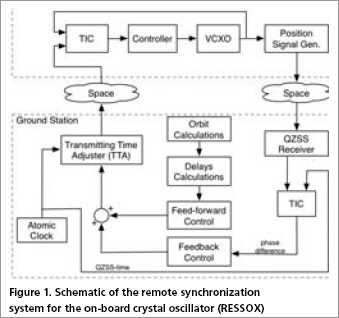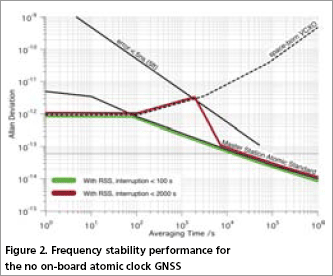| GNSS | |
Space-based positioning system with no on-board atomic clocks
|
|||||||||||||||||||||||||||||||
| The Japanese Quasi-Zenith Satellite System (QZSS) represents an innovative multi-service satellite system able to provide positioning for mobile users over Eastern Asia and Australasia. The integration of the QZSS with the present GPS and the European GALILEO will improve accuracy, availability and capability over a wide area. Throughout a collaborative research program, the space technology group of AIST, Japan and the University of NSW, Australia are studying the feasibility of a revolutionary remote synchronization scheme for implementing a QZSS with no on-board atomic clocks. It basically consists of a remote synchronization scheme where the satellite on-board time reference is constantly linked to a main atomic reference located in the ground station. An up-link/downlink network provides an opportune synchronization/correction signal that keeps the master time reference and the satellite time reference in lock-step. This revolutionary system will not require on-board atomic clock, in fact satellite clocks would just act as transponders, broadcasting the very precise time broadcast from the ground station.
This new concept of positioning system is now under study through the adoption of a dedicated hardware simulator as well as software simulator tools. The following paper presents an overview of the architecture and its advantages and disadvantages over the classic GPS scheme. GPS satellite clocksTo provide proper positioning signals, positioning system satellites, i.e. GPS satellites, need very accurate on-board time references. In fact, in order to achieve high stability, GPS satellites adopt very precise on-board atomic clocks. In such scenario, the satellite on-board time keeping system (TKS) is responsible for the synchronization of the on-board voltage controlled crystal oscillator (VCXO) with the on-board atomic clocks. Block II/ IIA satellites contain two cesium (Cs) and two rubidium (Rb) atomic clocks. Block IIR satellites contain three Rb atomic clocks. Consequently, satellites are fairly independent from ground station synchronization and, generally, only a daily time synchronization/correction is required. When GPS was conceived, it was recognized that the most difficult technology problem facing the developers was probably the need to fly accurate timing standards insuring that all satellites’ clocks remained synchronized [1]. Considering that light travels about 1 ft per ns (1X10-9 s), if the system can tolerate an error buildup caused by the on-board clocks of 5 ft, the on-board clock frequency stability should be roughly 5 ns per upload. Considering that visibility of GPS satellites, such upload can be performed every half day. Therefore the required frequency stability should be roughly (5X109)/(4X104) = 1.25 X 10-13 measured over 12 h. Such requirements can be met only by atomic clocks. GPS was born as a military-purpose application therefore, a strong independency from ground stations is certainly an important point. QZSS satellite clocksDespite similarities in the GPS signals, the QZSS orbit design greatly differs from that of GPS, and if a proper location is chosen permanent QZSS satellite view can be achievable. Furthermore QZSS is a civil system with completely different basic requirements. QZSS’s positioning capabilities will represent a new-generation civil GPS space augmentation system, with limited navigation capabilities. In other words, although the QZSS is seen primarily as an augmentation to GPS, without requirements or plans for it to work in standalone mode, QZSS can provide limited accuracy positioning on its own. The service also could be augmented with geostationary satellites in Japan’s MTSAT Satellitebased Augmentation System (MSAS) currently under development, which features a geostationary satellite-based design similar to the U.S. Federal Aviation Administration’s Wide Area Augmentation System (WAAS). Details of the QZSS orbit design and signal structure can be found in [2]. According to its original plan, QZSS satellites will be carrying two types of space-born atomic clocks; a hydrogen maser and a rubidium atomic clock. The positioning signal will be generated accordingly to these two clocks and an architecture similar to the GPS TKS will be employed. QZSS will be also provided with a Two Way Satellite Time a Frequency Transfer, TWSTFT, scheme that will be employed to gain some fundamental knowledge of satellite atomic standard behavior in space and for other research purposes. Among them there is the R&D of a revolutionary time synchronization system that aims to study the feasibility of a no on-board atomic clock GNSS. No on-board atomic clock GNSSWith a research program started in the 2003, the Space Technology Group in the National Institute of Advanced Industrial Science and Technology (AIST) of Tsukuba, Japan has been studying the feasibility of a novel time synchronization system for QZSS. The novelty of this research is based on the QZSS orbit design and on its high satellite visibility. Such a peculiar feature makes possible to reconsider the classic TKS structure as a remote TKS where the main time reference (atomic clock) is located on the ground in the control station and a correction/ synchronization infrastructure keeps the on-board time reference continuously synchronized. Seen in this way the novel TKS for QZSS is indeed a remote synchronization system (RSS) for the QZSS on board time reference. The feasibility of a synchronization method where one clock is in the ground and the other is flying in space is certainly a non trivial task. [3][4][5][6] are some of the numerous articles that report results of the undergoing research of the QZSS-RSS novel concept. Feasibility of QZSS-RSSTheoretically, if a communication channel between satellite and ground station could be kept open, the difficulties in synchronizing the two clocks lies in knowing what the phase shift between the two clocks is and in knowing how to proper steer the remote on-board clock. Fig. 2 shows the Allan variance of the atomic reference that could be adopted at the ground station, the Allan variance of the satellite on-board clock, a space-born VCXO, and the curve that represent the requirement for a maximum 5 ft buildup error (5 ns). If the phase shift between the on-board clock and the ground clock could be estimated within a certain accuracy, the synchronization system should correct the on-board time in order to get a total stability represented by the red time. One of the goal of the AIST project is study the feasibility of such system. One of the big issues regarding this architecture is to understand what could happen when the synchronization is lost. For instance, when QZSS satellites cross the equatorial region, groundsatellite communications have to be turned off, leaving the satellite on its own for at least 11 minutes, twice a day. Looking at Fig. 2, it can be noticed that a VCXO on its own tends to drift much more and faster than an atomic reference. Considering 5 ft or 5 ns as the acceptable limit for the maximum buildup error caused by the on-board clock, the satellite must be resynchronized at least every 2000 s (33 minutes). QZSS-RSS, practical implementationIwata et al. [3] proposed the first concrete implementation to realize this synchronization technology for QZSS. The idea is based on the compensation of the ground station satellite delays through prediction. Fig. 1 presents a simplified schematic of the remote synchronization system for the onboard crystal oscillator (RESSOX). The precise time available at the ground station (QZSS-time) is “advanced” by means of the Transmitting Time Adjuster (TTA) and then uploaded to the satellite. Here, a PLL architecture is implemented to steer the local on-board clock, a VCXO, and keep it locked to the received signal. The output of the VCXO is used to construct the QZSS positioning signal that is then broadcast to the user. The key point is to keep the ground station clock and the on-board VCXO synchronized by controlling the TTA such that all communication delays are compensated. To do this, a double feedback and feedforward control loop, based on orbit prediction and delay calculation, are used. A detailed description of this method can be found in [3] [5]. AIST and the University of NSW are now investigating the feasibility of a second method, a method based on the TWSTFT scheme, available for QZSS. This new control method is characterized by its great simplicity and it is designed specifically for the QZSS. It does not require any on-board atomic clock and, unlike RESSOX does not require any satellite position prediction nor any delay calculation. Its architecture resembles the structure of the TKS for the classic GPS where, instead, the control voltage that drives the VCXO is processed remotely, in the ground station. Hence it has been named Remote Time Keeping System, RTKS. In [4] the TWTT method and its implementations in the QZSS are described. Phase shift measurementAs mentioned early, the real-time or quasi real-time determination of the phase shift between the ground station clock and the on-board clock, is a fundamental requirement for the realization of QZSS-RSS. Presently two strategies are under study. The architecture proposed in [3], being totally based on satellite position prediction and delay estimation, relies on the ability of predicting what the phase shift is. The implementation of an additional feedback that make the whole system more robust in now under study. Synchronization accuracy of the order of 4 ns are achievable for this scheme. The second architecture, recently proposed in [4] takes advantage of the TWSTFT scheme. Now under test on board the ETS-VIII and, in the future, available for QZSS, the TWSTFT method is expected to offer accuracy of the nanosecond order at all times. VCXO control AlgorithmOne of the key points for the realization of RSS for RESSOX is the implementation of a controller for the on-board VCXO that can combine the good short-term stability of the VCXO with the good long-term stability of the ground station atomic standard. When the synchronization information is upload-able, such controller should be able to keep the VCXO looked to the ground station clock within acceptable limits. In [6] the authors report a successful implementation of such controller where the Allan variance of the controlled VCXO is largely below the 5 ns requirements. ConclusionsWith the opportune shrewdness, the basic idea that lies behind the QZSSRSS could theoretically be applied to other GNSSs. The two proposed methods, [3] [4], are practical implementations of this remote synchronization concept specifically made for QZSS. Both schemes could theoretically be applicable to a worldwide GNSS, i.e. GPS or GALILEO. For such systems, all time view is not applicable and more ground stations would be necessary to guarantee the necessary synchronization update. Beside being a very interesting research topic, the idea of a GNSS with no on-board atomic clocks would offer several advantages in term of satellite cost, life expectancy and satellite power consumption. This concept could be advantageously applicable to Low Earth Orbit, LEO, positioning systems, [7], where satellite weight is clearly a critical issue. References[1] Bradford, W., Parkinson, J.J., Spilker, Jr.: Global Positioning System: Theory and Applications Volume I, AIAA, (1996). [2] Petrovski IG et al. QZSS – Japan’s New Integrated Communication and Positioning Service for Mobile Users, 2006, GPS World, vol. 14, n.6, pp 24-29. [3] Iwata, T. et al. Remote Synchronization System for On- Board Crystal Oscillator of Quasi-Zenith Satellite System, International Symposium on GPS/ GNSS, 2003, pp. 375-380. [4] Tappero et al. Remote Control System for the Quasi-Zenith Satellite Crystal Oscillator Based On the Two- Way Time Transfer Method . IGNSS Symposium 2006. 17, 21 July 2006. Holiday Inn Surfers Paradise, Australia. [5] Tappero et al. Hardware Experimental Setup for the Remote Synchronization System of Onboard Crystal Oscillator. 48th Space Sciences and Technology Conference, Fukui, Japan, 4-6 Nov. 2004. [6] Tappero et al. Control Algorithm of the Hardware Simulator For a Remote Synchronization System for the Japanese Quasi-Zenith Satellite System. ION NTM 2005 Conference, January 24-26, 2005, in San Diego. [7] Regional positioning system using low earth orbit constellations, Der-Ming Ma. Acta Astronautica. 2006, vol. 58, pp 387-394. |
|||||||||||||||||||||||||||||||
|
|||||||||||||||||||||||||||||||
|
















 (No Ratings Yet)
(No Ratings Yet)





